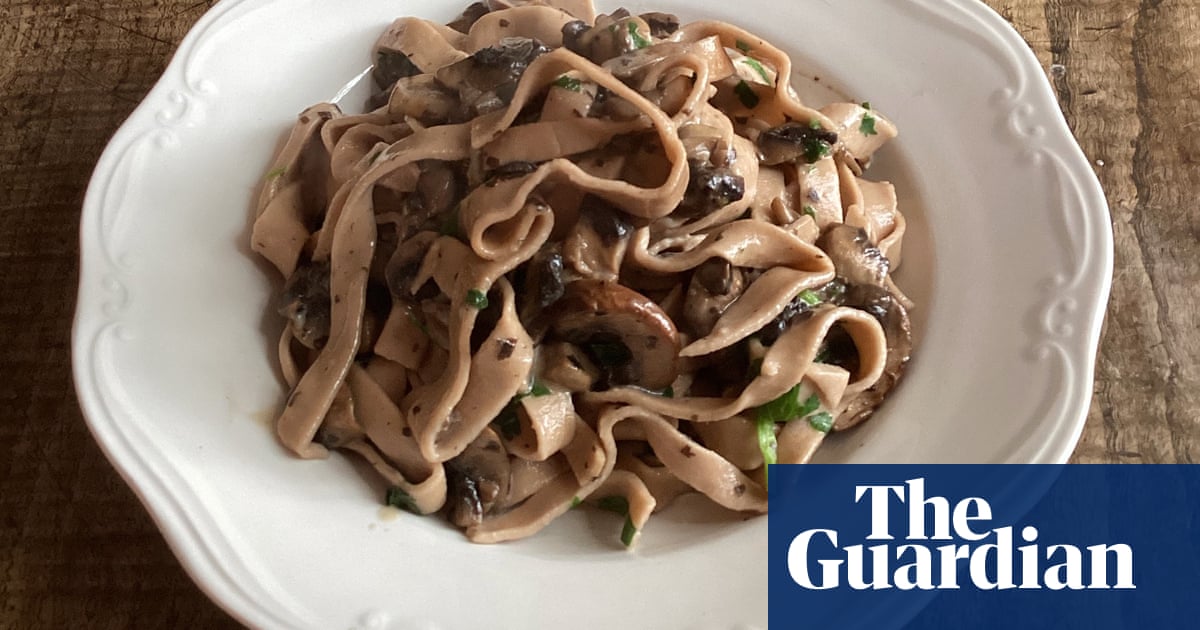As anyone who has picked up a winking chestnut and rolled it around the palm of their hand knows, sweet chestnuts are heavy things – too heavy to be spread by animals or birds, meaning the chestnut landscape is largely man-made. Throughout history, chestnuts have been planted to provide food (especially in areas that are not suitable for grains), wood and fuel, or as a gift for future generations. In her charming and informative book On Chestnuts: the Trees and their Seeds, Ria Loohuizen recalls a saying from France: “One plants a peach for oneself, an olive tree for one’s son, a chestnut tree for one’s grandson.”
Sweet chestnuts are not picked: they fall from the tree when they are ripe, so need to be collected, on mats or by big vacuums. A friend of ours in Abruzzo, where chestnuts have always been of great economic importance, has a friend who built his own collector that consists of a soft wire basket on a stick which he rolls over the ground so the nuts squeeze between the gaps.
Traditionally, chestnut flour was made by drying the chestnuts in special huts, on racks over a low-burning fire. Once dried, they were peeled and milled. In the 1920s, the mechanisation of peeling revolutionised the process, meaning the nuts could be peeled first, then dried by modern methods, before being reduced to flour. Like the chestnuts it’s made from, the flour is naturally sweet, which is why it is sometimes known as farina dolce, or sweet flour. That said, it has a savoury sweetness, and is ever so slightly astringent, which is why chestnut flour works so well in savoury dishes: bread, polenta, pancakes and, as in today’s recipe, pasta.
Its lack of gluten means it needs the support of plain flour, too; Carla Tomasi, a gardener and my teacher, suggests a 50:50 split.
Loohuizen also remarks that the sweet chestnut is a “sociable” tree, and how it has a symbiotic relationship with the mushrooms that grow in the shaded soil near the base of its trunk. The friends are reunited in this week’s recipe, for which 500g mixed mushrooms (chestnut, button, field, oyster) are cooked in a generous amount of butter with herbs, and are then tossed with Harris tweed ribbons of chestnut pasta.
Chestnut pasta with mushrooms and herbs
Prep 30 min
Rest 30 min
Cook 10 min
Serves 4
200g chestnut flour
200g plain white flour
4 eggs
500g mixed mushrooms – chestnut, button, field, oyster
60g butter
3 tbsp olive oil
2 garlic cloves, peeled and bashed
1 sprig fresh thyme
100ml thick cream (optional)
Salt and black pepper
A handful of parsley, minced
First, make the pasta. On a board, in a bowl or in a food processor, mix both flours and the eggs until you have a firm dough. Leave it to rest, covered by an upturned bowl, for 30 minutes, roll out using a machine or rolling pin, cut into roughly 20cmx 10cm sheets, then cut the sheets into 8mm-wide ribbons. Bring a large pan of well-salted water to a boil.
Slice the mushrooms (halve or quarter larger ones first, if necessary). In a large, deep frying pan or wok set over a medium-low heat, melt the butter and olive oil with the garlic and thyme, until the butter foams gently. Add the mushrooms and a pinch of salt, and cook, stirring, until they collapse. Let the mushrooms bubble gently in their juices for eight to 10 minutes, adding the cream, if using, and a few grinds of black pepper.
Meanwhile, cook the pasta, which will take about three minutes (keep testing while it boils), then lift it directly into the mushroom pan along with the minced parsley. Toss everything thoroughly, and serve.
-
Discover this recipe and many more from your favourite cooks in the new Guardian Feast app, with smart features to make everyday cooking easier and more fun
